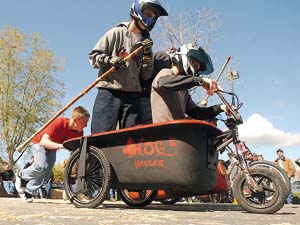At a time when many kids are more focused on what clothes to
wear or their favorite video game, some local teens say they have
only one vision for their future and it involves farms, animals and
living off the land.
Hollister – At a time when many kids are more focused on what clothes to wear or their favorite video game, some local teens say they have only one vision for their future and it involves farms, animals and living off the land.
It’s been almost 80 years since the Future Farmers of America was started to educate youth about careers in agriculture. Nearly half a million members and over 7,000 chapters later, it is still alive and well in San Benito County.
Take Hollister’s Nicole Silveira, for example. While other students are baby-sitting or flipping burgers to save money for their prom dresses, the 16-year-old Silveira is selling pigs. Every day, she takes several of her pink, plump pets around the broccoli fields off Wright Road, to make sure they are lean in time for the San Benito County Fair in July. That’s when she sells them – for $150 to $200 a piece.
“It’s a good business to get involved in,” said Silveira, president of Future Farmers of America at San Benito High School.
Silveira is one of 85 students at the school who belong to the national organization and celebrated FFA Week with several events throughout the week and a barn dance this evening. When she graduates, Silveira plans on going to Cal Poly, San Luis Obispo and eventually becoming an ag teacher.
The junior attends a slew of agricultural conferences, workshops and fairs, where she applies the skills she’s learned in the classroom to keep track of the pigs she’s sold, network with other farmers and find out what’s new in the industry.
“It’s a good organization to help you get started in the real world,” she said.
The national FFA, which has almost half a million members and was started in 1928, stresses leadership building skills and training for potential careers in agriculture from food and veterinary science to viticulture and mechanics.
“There is a misconception that you have to come from a farm, but the truth is these classes are for everybody,” said Kelly Bianchi, who teaches all of the agriculture classes and heads the FFA program at San Benito High School. Bianchi was an FFA member growing up and studied agricultural education at Fresno State University and Cal State Polytechnic in San Luis Obispo.
Enrollment in the high school program has jumped by at least 25 students in the last two years as more students now take classes such as agricultural economics, biology and leadership, said Bianchi. The classes have recently been restructured to meet graduation requirements at the University of California and California State University colleges, providing another reason why the FFA tradition is strongly continued today.
Although Silveira’s family is not involved in agriculture, others in the program come from a solid ag background. Roger Pereira, a 17-year-old who is also in San Benito High’s FFA, comes from a family of dairy farmers and plans on coming back to work on the ranch after college. His dad, Tim Pereira, is a former FFA member himself, who grew up in San Benito County.
“It’s amazing that it made it this far,” he said. “But it’s a good program because it teaches them a lot of things.”
And despite the exodus by many modern students to the high-tech sector, there are plenty of jobs locally that require the very skills FFA teaches, said Charlie Tobias, a large animal veterinarian who is also on the advisory committee of the local FFA chapter.
“There’s a tremendous need for it (skills),” said Tobias. “There are new vineyards being put in (in San Benito County), new greenhouses. Not everyone is going to be a rocket scientist.”
Karina Ioffee covers education and agriculture for the Free Lance. Reach her at (831)637-5566 ext. 335 or ki*****@***********ws.com










